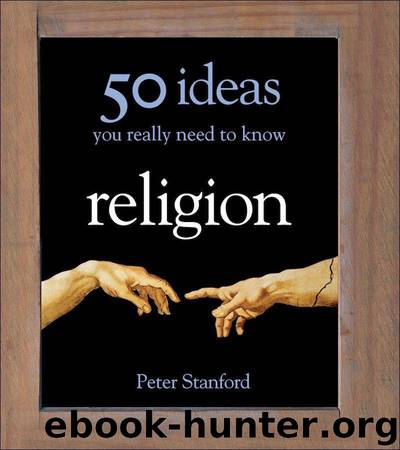Religion - 50 Ideas You Really Need to Know (50 Ideas You Really Need to Know series) by Peter Stanford

Author:Peter Stanford
Language: eng
Format: mobi, epub
Publisher: Quercus
Published: 2010-04-26T23:00:00+00:00
the condensed idea
Anti-semitism is the oldest prejudice
timeline
3rd century BCE Anti-Jewish riots in Alexandria
1st century CE First ‘blood libel’
338 First record of synagogue burnt by Christians
1144 Murder of William of Norwich
1939–45 Nazi Holocausts
1965 Vatican clears Jews of deicide
26 The birth of Islam
The story of the growth of Islam is a remarkable one. In 610 CE, the Prophet Muhammad received the word of God on a lonely mountaintop just outside the holy city of Mecca in present-day Saudi Arabia. A century after his death in 632, belief in the message he had received had spread westwards along the coast of North Africa as far as Spain, and in the opposite direction all the way to the Himalayas. At first Allah’s revelations to Muhammad were shared orally, but after his death they were written down as the Qur’an – a word that means ‘recitation’.
Muhammad was a merchant by profession, working in Mecca. The city had grown rapidly into a major trading post, a transformation that had brought with it social tensions. It was also a religious centre, a place of pilgrimage or hajj, where Arabs would come to worship their various tribal gods. Though they knew of the Jewish and Christian traditions of having but one god, and felt no hostility to them, they preferred a vaguer spiritual code that gave tribal solidarity – called muruwah – a sacred value.
Muhammad believed that a coming together of beliefs would bring greater peace and justice. Once a year he would retreat to a cave outside Mecca to pray for guidance – and to distribute alms to the growing number of poor and marginalized in the city. In 610, when he was 40 years old, he was alone in the cave when, according to his own description, he was gripped by an overwhelming embrace. At first he thought he was being attacked by a djinn – or evil spirit – but it was in fact the Angel Gabriel speaking the words of a new Arabic scripture direct from God, or Allah.
Muhammad’s family
Muhammad’s first wife, Khadijah, was older than him and a widow of independent means when they married. Though polygamy was the norm in Arabia at the time, Muhammad took no other wife while she was alive. They had at least six children – two sons, Al-Qasim and Abdullah, who died in infancy, and four daughters, Zaynab, Ruqayyah, Umm Kulthum and Fatimah. Khadijah died in 619, in what Muhammad’s early biographers call his ‘year of sadness’. After that he married at least nine more times, often for political or humanitarian reasons. The homely Sawdah, for instance, another widow, was the cousin of a local tribal chief. His favourite wife, according to Sunni Muslims, was Aisha, who was only six years old when they were betrothed. After his death, she was involved in collecting his teachings in the Hadith. Another wife, Zaynab bint Jahsh, was first married to one of his adopted sons, but they divorced so Muhammad could wed her. Islam teaches that the Prophet was
Download
Religion - 50 Ideas You Really Need to Know (50 Ideas You Really Need to Know series) by Peter Stanford.epub
This site does not store any files on its server. We only index and link to content provided by other sites. Please contact the content providers to delete copyright contents if any and email us, we'll remove relevant links or contents immediately.
Periodization Training for Sports by Tudor Bompa(7328)
The MacArthur Bible Commentary by John MacArthur(4237)
The Body: A Guide for Occupants by Bill Bryson(3801)
The Sports Rules Book by Human Kinetics(3588)
What It Really Takes to Get Into Ivy League and Other Highly Selective Colleges by Hughes Chuck(3221)
Marijuana Grower's Handbook by Ed Rosenthal(3118)
The Sprouting Book by Ann Wigmore(3052)
Salt, Fat, Acid, Heat: Mastering the Elements of Good Cooking by Nosrat Samin(2658)
The Martian by Andy Weir(2610)
Classic by Mary Berry(2501)
The Bread Bible by Rose Levy Beranbaum(2472)
Harry Potter 4 - Harry Potter and The Goblet of Fire by J.K.Rowling(2416)
Sapiens and Homo Deus by Yuval Noah Harari(2414)
The Marketing Plan Handbook: Develop Big-Picture Marketing Plans for Pennies on the Dollar by Robert W. Bly(2413)
Martha Stewart's Baking Handbook by Martha Stewart(2331)
50 Economics Classics by Tom Butler-Bowdon(2066)
Screenplay: The Foundations of Screenwriting by Syd Field(2057)
The Cambridge Grammar Of The English Language by Rodney Huddleston Geoffrey K. Pullum(2046)
The Plant Paradox by Dr. Steven R. Gundry M.D(2039)
